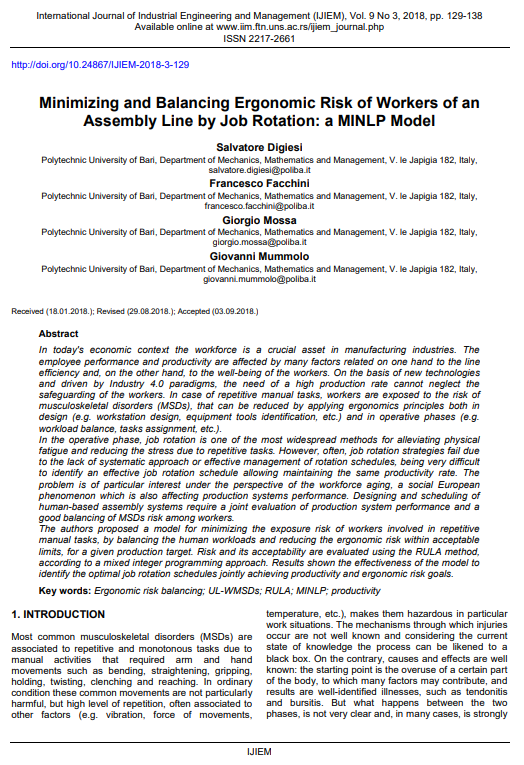Minimizing and Balancing Ergonomic Risk of Workers of an Assembly Line by Job Rotation: A MINLP Model

Published 2018-09-30
abstract views: 134 // FULL TEXT ARTICLE (PDF): 0
Keywords
- Ergonomic risk balancing,
- UL-WMSDs,
- RULA,
- MINLP,
- productivity
How to Cite
Copyright (c) 2023 International Journal of Industrial Engineering and Management

This work is licensed under a Creative Commons Attribution 4.0 International License.
Abstract
In today's economic context the workforce is a crucial asset in manufacturing industries. The employee performance and productivity are affected by many factors related on one hand to the line efficiency and, on the other hand, to the well-being of the workers. On the basis of new technologies and driven by Industry 4.0 paradigms, the need of a high production rate cannot neglect the safeguarding of the workers. In case of repetitivemanual tasks, workers are exposed to the risk of musculoskeletal disorders (MSDs), that can be reduced by applying ergonomics principles both in design (e.g. workstation design, equipment tools identification, etc.) and in operative phases (e.g. workload balance, tasks assignment, etc.).In the operative phase, job rotation is one of the most widespread methods for alleviating physical fatigue and reducing the stress due to repetitive tasks. However, often, job rotation strategies fail due to the lack of systematic approach or effective management of rotation schedules, being very difficult to identify an effective job rotation schedule allowing maintaining the same productivity rate. The problem is of particular interest under the perspective of the workforce aging, a social European phenomenon which is also affecting production systems performance. Designing and scheduling of human-based assembly systems require a joint evaluation of production system performance and a good balancing of MSDs risk among workers. The authors proposed a model for minimizing the exposure risk of workers involved in repetitive manual tasks, by balancing the human workloads and reducing the ergonomic risk within acceptable limits, for a given production target. Risk and its acceptability are evaluated using the RULA method, according to a mixed integer programming approach. Results shown the effectiveness of the model to identify the optimal job rotation schedules jointly achieving productivity and ergonomic risk goals.
Article history: Received (18.01.2018); Revised (29.08.2018); Accepted (03.09.2018)

